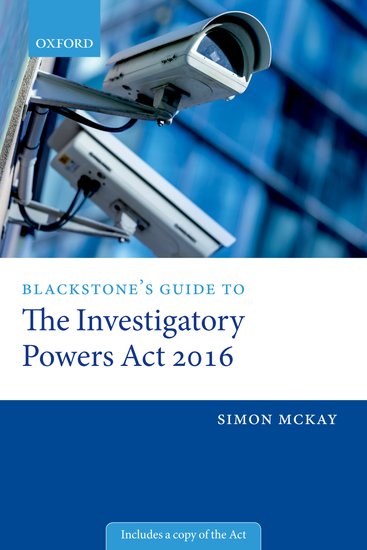Book review: Blackstone’s Guide to the Investigatory Powers Act 2016, by Simon McKay
The Investigatory Powers Act 2016 (IPA) is the latest step in bringing the hitherto unknown surveillance activities of the State into the light and under statutory control through ‘world-leading oversight’, or — depending on your point of view — the “the most intrusive surveillance regime of any democracy” that legitimises the surveillance State. (The former was how then Home Secretary Amber Rudd described it in a departmental press release; the latter was the reaction of the human rights campaign group, Liberty.)

Reviewed by Lorna Woods
While some may question the quality of the Parliamentary debates on the bill itself, the process of reviewing surveillance practices culminating in the enactment of IPA took some considerable time and involved a series of reports from a range a bodies — the most significant of which are ‘Privacy and Security: A Modern and Transparent Legal Framework’ (HC 1075, 12 March 2015) by the Intelligence and Security Committee (ISC); the Royal United Services Institute (RUSI) Review (A Democratic Licence to Operate: Report of the Independent Surveillance Review, 13 July 2015) and the report by the then Independent Reviewer of Terrorism Legislation, David Anderson QC, ‘A Question of Trust’ (June 2015) as well as the report of the Joint Committee on the Draft Bill. These reviews point out some of the political, technical and drafting complexities of the regimes. The end result of the process was a long, complex and difficult to understand Act — as the introduction to the Guide notes (at p 1), the IPA is many times longer than the acts it replaces ‘coming in at an eye-watering 272 provisions, ten schedules, and 305 pages’. Given this, some sort of map through the text to explain the meaning of the provisions and their interrelationship is desirable to help improve accessibility. It is this function that Simon McKay’s Guide carries out.
The Guide is split roughly in half, with the latter half of the book constituting an appendix containing the IPA itself; relevant codes of conduct were not included — at the time of writing most were in draft. The first half of the Guide constitutes the commentary which is divided into 10 chapters, which after an introductory historical chapter broadly follow the structure of the IPA, tackling each part of the IPA in chronological order. The tenth chapter is perhaps an exception as it covers the miscellaneous (but important) provisions at the end of the main text of the IPA but then tackles some provisions from the schedules, namely those dealing with the provisions dealing with the combination of warrants. It does not comment comprehensively on all matters found in the schedules but does, however, provide an overview of some of the law relating to covert policing found elsewhere — the Intelligence Services Act 1994 (ISA), Part II of the Police Act 1997 and the remaining Part II of the Regulation of Investigatory Powers Act 2000 (RIPA). This latter section is important as the IPA though it sought to provide a coherent, overarching system for state surveillance, did not constitute a complete system nor did it repeal all pre-existing provisions. It is therefore important to understand the linkages between IPA and the ‘old’ provisions remaining. In all, the Guide provides a complete overview of the IPA and places it against some of the existing jurisprudence.
The first chapter provides a succinct and clear overview of the development of legislation in this field from Malone v United Kingdom (1984) 7 EHRR 14 and the Interception of Communications Act 1985 (IOCA) onwards and including judicial challenges both domestically and before the European courts. This then provides a helpful background to a discussion of the IPA, some provisions of which show a close family resemblance to that which has gone before. The preliminary assessment of the IPA (at Part E, Chapter 1) similarly usefully synthesises both the strengths and challenges to the regime established by IPA. Most of the chapters carry an introductory section, providing some history as well as identifying key points of dispute. In some later parts of the Guide, the substance of the IPA is set against the context of existing jurisprudence as can be seen, for example, in the discussion of journalists’ sources/journalists’ materials (paras 4.83 et seq.; para 6.60), the development of the use of a single point of contact (SPOC), and the introduction to the oversight arrangements. In general, the Guide sticks closely to the text, paraphrasing the text, albeit often highlighting structural or thematic aspects, for example making it clear that there are three categories of communications data made up of entity and events data (para 1.79, see for other examples 3.154, 3.158, 4.15); or identifying where there are commonalities in approach between provisions. It does so in appropriate detail, precisely referenced. In organising the material the Guide makes the connections between sections and parts more obvious, making the text a little more accessible (the IPA will never be easy to understand). The section on Part 7 IPA on Bulk Personal Data sets, for example, is helpful in establishing clearly when the provisions are engaged and the similarities to and differences from the regimes in relation to other forms of surveillance — the IPA is particularly opaque in this area.
While this approach is helpful in understanding the operation of the IPA, and what the function of the sets of provisions is, sometimes this sort of opportunity is unfortunately missed. For example, in para 3.83, dealing with modification of warrants, does not make it clear that there are two types of modification; this point is much clearer in para 3.95. Further, if a general criticism might be made it is that, although the structuring of the material may help comprehend the requirements of particular provisions, the significance of those provisions or of any change from the previous regimes is not always made explicit. So the concerns surrounding the use of regulations, particularly in relation to codes of conduct is only hinted at (e.g. s. 267(1) IPA discussed para 1.73; see further discussion 4.58 et seq ). While there are instances when the similarity to or difference from the previous regimes is noted (see e,g, 3.45, 3.121, 3.152, 4.05), this is not always the case. For example, the Guide, in its discussion of the generally applicable definitions, contrast these definitions with those used in previous legislation — which would give us an idea of whether there had been an extension of scope here as well as through an extension of powers. While some of the evidence submitted to the Joint Bill Committee may have been non-technical or lobbying, there was some that dealt with these definitional issues from a legal analytical perspective that could well have been drawn on here and which would have added greater analytical depth to this section (e.g. Graham Smith’s written evidence on the difference between content and communications data).
There are unfortunately some production errors. All books contain typos but they seem quite numerous in this text (see e.g. paras 1.36; 1.58). There seems to be some repetition (compare paras 2.03 and 2.08; 3.06 with material in chapter 1) and sometimes even the same phraseology is repeated throughout the book (see discussion of legal professional privilege). Presumably this is a result of the speed at which the Guide was produced.
While this Guide goes some way to providing a framework to assist understanding what the IPA is about and places it to some extent in context, all of which is useful, there are some weaknesses too, perhaps as a result of the Guide coming out quite soon after the enactment of IPA. While Simon McKay’s expertise in the law relating to secret policing and surveillance is evident, it is not consistently brought into play. While accurate description is essential and neutrality as to whether surveillance powers are good and proper things is understandable if not desirable, this Guide would have been improved had it been clear about where controversies and uncertainties lie. Given the range of legal challenges against it recently decided * and currently underway, not to mention Brexit, it may be that no Guide could currently provide a full and enduring picture. Nonetheless, the Guide provides a useful starting point for someone seeking to understand the IPA in its entirety or how particular powers are structured.
* Notably Privacy International v Secretary of State for Foreign and Commonwealth Affairs [2016] UKIPTrib 15_110–CH [2017] 3 All ER 647 concerning bulk personal data sets and bulk communications data; R (National Council for Civil Liberties) v Secretary of State for the Home Department [2018] EWHC 975 (Admin); [2018] WLR(D) 269.
Lorna Woods is Professor of Internet Law at the University of Essex
